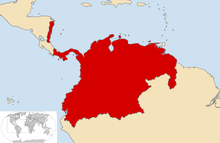Viceroyalty of New Granada
The Viceroyalty of New Granada ( Spanish : Virreinato de Nueva Granada ) was a Spanish viceroyalty in South America , comprising the present-day states of Venezuela , Colombia , Panama , and Ecuador . It also laid claim to the Miskito Coast , which was ruled by the Kingdom of England and the Kingdom of Great Britain . Its capital was first Cartagena de Indias and then Santa Fé de Bogotá (today Colombia), it was divided into governorships (gobernaciones) subdivided.
story
The viceroyalty was founded on May 27, 1717 under the name Virreinato de Santa Fe del Nuevo Reino de Granada . Dissolved in 1723, it was re-established in 1739 under the name of Virreinato de Nueva Granada .
The viceroyalty was formed from parts of the existing Spanish viceroyalty of New Spain and Peru , making it the third Spanish viceroyalty on American soil. New Spain consisted of much of what is now the United States , Mexico , the Caribbean islands , Central America except for Panama , and the Philippines , northern Borneo , and some Pacific islands. It also included Venezuela until the founding of New Granada. Peru originally included the entire part of the South American continent to which Spain was entitled under the Treaty of Tordesillas , with the exception of Venezuela, as well as Panama and the Miskito Coast ( ceded to England in 1655 ).
The creation of another viceroyalty became necessary after the vast areas under Spanish rule became increasingly difficult to administer in a single viceroyalty. At that time, all goods that were imported or exported to and from Spain first had to be transported via the Isthmus of Panama and then via the capital of the Viceroyalty of Peru, Lima . There they were taxed or levied, which led to considerable corruption .
The choice of Bogotá as the capital soon turned out to be unfavorable, since it was located at an altitude of 2600 m and was difficult to reach by water, the Río Magdalena , and from Honda only on a difficult land route.
Later, in 1776, a fourth viceroyalty, Río de la Plata (today: Argentina , Bolivia , Uruguay and Paraguay ), was established.
After the viceroyalty gained independence from 1810, what is now the Republic of Colombia initially adopted the name New Granada ( República de la Nueva Granada ) until becoming part of Greater Colombia in 1819. After the dissolution of Greater Colombia through the secession of Venezuela and Ecuador in 1830, Colombia continued to bear the name of the former viceroyalty until 1861.
literature
- John R Fisher, Allan J Keuthe, Anthony McFarlane: Reform and Insurrection in Bourbon New Granada and Peru . Louisiana State University Press, Baton Rouge 1990, ISBN 0-8071-1654-8 .
- Alan J. Kuethe: Military Reform and Society in New Granada, 1773–1808 . University Presses of Florida, Gainesville 1978, ISBN 0-8130-0570-1 .
- Anthony McFarlane: Colombia Before Independence: Economy, Society and Politics under the Bourbon Rule . Cambridge University Press, Cambridge 1993, ISBN 0-521-41641-8 .
- John Leddy Phelan: The People and the King: The Comunero Revolution in Colombia, 1781 . University of Wisconsin Press, Madison 1978, ISBN 0-299-07290-8 .
itemizations
- ↑ History | Colombia. In: www.kolumbien.de. Retrieved 8 August 2015 .
- ↑ El archipiélago de Los Monjes y las relaciones diplomáticas con Venezuela: Historia de una cesión territorial cuyas consecuencias siguen vigentes - banrepcultural.org. In: banrep.gov.co. Retrieved March 28, 2017 .
- ↑ Viceroyalty. In: www.lai.fu-berlin.de. Retrieved 8 August 2015 .
- ↑ Miguel Alejandro Malagón Pinzón: El constitucionalismo colombiano de 1810 a 1830. Una pervivencia del modelo de administración colonial . In: Pablo Rodríguez Jiménez (ed.): Historia que no cesa. La independencia de Colombia, 1780–1830 . Universidad del Rosario, Bogotá 2010, ISBN 978-958-738-101-6 , pp. 203–211.

